1-a: I am from a small suburban township in north eastern PA called Sugarloaf. Just outside of Hazleton, it is one of many small townships and boroughs in the area. Our water utilities come from the Conyngham Borough Water Authority, a neighboring municipality. In Conyngham, there are just five wells, a reservoir, and a holding tank. These provide the sources of water for about 1,000 connections, including commercial and residential. While the majority of the connections are residential, some of the largest include an elementary/middle school and a gas station. From the wells and reservoir, water is pumped into the tank. A gravitational system, as well as pumps, feed the water into direct lines to buildings where it is used and drained into a 4 inch pipe that feeds into a main line. An interceptor brings the waste water to a treatment facility in Conyngham where it is recycled and moved back into the reservoir and tank.
1-b:
1-c: I failed this experiment within 5 minutes of being awake… yikes. As it is a requirement to look clean and professional when conducting ROTC activities, I had to shower before going to my class. I attempted to take a short shower, but with my high-flow shower head, I probably used 25 gallons in only 5 minutes. Nevertheless, I still attempted to use as little as possible! I decided to primarily focus on cutting down on drinking and cooking water, toilet water and sink water. My typical daily gallon of drinking water was curbed by eating lots of raw food with natural water, like vegetables, which also eliminated cooking water. I drank about a half gallon. I convinced my roommates to not flush the toilet all day, but I could not stop the automatic-flush public toilet I used once. Hand sanitizer replaced sink water, and I used only a sprinkle of water for teeth brushing. With the exception of my shower, I’m pleased to say I stayed under the two gallon limit. If I had conducted this experiment on a weekend, I would definitely skip the shower. The thing I’m not pleased about is that something so small like flushing our toilet the next day (literally) flushes down the possibility of continuing the 2 gallon challenge long term. This was a huge wake-up call, seeing the amount I effortlessly use on a daily basis, compared to how limited some people are. Geography is a key player in water use, because it is directly affected by water availability and other resources. I believe my hometown can do so much more collective and individual action to ensure we maintain our small water supply.


Hi Hannah! My name’s Lexie, heres my post :
http://geog030.dutton.psu.edu/2016/02/09/lexie-gersbacher-syracuse-water-supply/
Your post caught my eye because you said you were from Sugarloaf and I was actually at the Hazleton branch campus for 2 years! It was interesting to read where they get their water supply from. It seems like a lot of people in Pennsylvania get their water supply from wells which is different from where i’m from. In upstate NY where i’m from, our water comes from a lake, through pipes and then into our faucets and bottles of water. I definitely think it’d be very, very hard to only be available to 2 gallons of water a day.